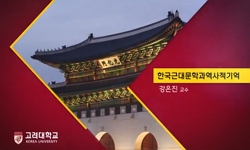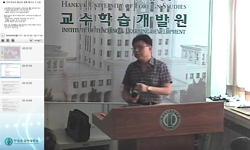The paintings of Raja Ravi Varma and Abanindranath Tagore, the two most influential South Asian artists of the late 19th and early 20th century, are usually considered to be contrasting examples of modern Indian art due to the disparate medium of the...
http://chineseinput.net/에서 pinyin(병음)방식으로 중국어를 변환할 수 있습니다.
변환된 중국어를 복사하여 사용하시면 됩니다.
- 中文 을 입력하시려면 zhongwen을 입력하시고 space를누르시면됩니다.
- 北京 을 입력하시려면 beijing을 입력하시고 space를 누르시면 됩니다.


인도 근대 미술의 여성상과 민족주의(Nationalism)의 성장: 바르마와 타고르의 회화를 중심으로 = Female Imagery and Nationalism: Women in Early 20th-century South Asian Paintings of Varma and Tagore
한글로보기부가정보
다국어 초록 (Multilingual Abstract)
In this paper I argue that both artists contributed greatly to the construction of the traditional Indian woman as a visual icon, which later came to represent independent India. Varma's female figure, especially his Hindu goddesses, were received with great praise from Europeans as well as the South Asian elite. These figures of Hindu goddesses and literary heroines were replicated through the use of lithographs, and efficiently dispersed the notion of India as a monolithic, united entity. Tagore's female figure was based on Varma's notion of India as a woman; however Tagore and later artists of the Bengal School of Art rejected the overt sensuality and power of Varma's goddesses, choosing to emphasize the inner spirituality of the East.
Unlike Varma's earlier paintings, which depicted a tableau of diverse women as the diverse aspects of India, his later Hindu goddess paintings were exclusively 'Hindu.' Tagore's paintings, based on the early 20th-century Hindu Nationalism of the Bengali elite, also visually rejected the participation of non-Hindus in the building of a new nation. However, Varma's Hindu goddess paintings and prints remain relevant to the contemporary world, as seen in millions of posters and popular art, due to the multiple connotations and nuances inherent in their production and analysis. On the other hand, Tagore's female figure, as seen in <Mother India (1905)>, no longer remains a visual icon, due to its fragmentary visual construction of the nation state.
The paintings of Raja Ravi Varma and Abanindranath Tagore, the two most influential South Asian artists of the late 19th and early 20th century, are usually considered to be contrasting examples of modern Indian art due to the disparate medium of their paintings or the distinct approaches found in contemporaneous and later reviews of their works. However, a striking similarity may be found between the two artists' depiction of female figures, with both artists appropriating literary and mythological figures dressed in traditional Indian garb.
In this paper I argue that both artists contributed greatly to the construction of the traditional Indian woman as a visual icon, which later came to represent independent India. Varma's female figure, especially his Hindu goddesses, were received with great praise from Europeans as well as the South Asian elite. These figures of Hindu goddesses and literary heroines were replicated through the use of lithographs, and efficiently dispersed the notion of India as a monolithic, united entity. Tagore's female figure was based on Varma's notion of India as a woman; however Tagore and later artists of the Bengal School of Art rejected the overt sensuality and power of Varma's goddesses, choosing to emphasize the inner spirituality of the East.
Unlike Varma's earlier paintings, which depicted a tableau of diverse women as the diverse aspects of India, his later Hindu goddess paintings were exclusively 'Hindu.' Tagore's paintings, based on the early 20th-century Hindu Nationalism of the Bengali elite, also visually rejected the participation of non-Hindus in the building of a new nation. However, Varma's Hindu goddess paintings and prints remain relevant to the contemporary world, as seen in millions of posters and popular art, due to the multiple connotations and nuances inherent in their production and analysis. On the other hand, Tagore's female figure, as seen in <Mother India (1905)>, no longer remains a visual icon, due to its fragmentary visual construction of the nation state.
국문 초록 (Abstract)
이 논문은 바르마와 타고르의 대표적인 작품에 나타난 여성상을 살펴보며 이러한 여성상이 독립 인도의 이상적인 모습을 시각적으로 구축하는데 큰 영향을 끼쳤음을 보여주고자 한다. 바르마의 여성상, 특히 힌두 여신의 표현은 유럽인들과 인도인 엘리트 계층에게 전반적인 호평을 받았다. 이러한 여성상은 석판화라는 매체를 통하여 인도 전역의 대중에게 널리 전파되면서 인도라고 하는 근대적인 통일 국가의 개념을 힌두 여성으로 표현한 선례를 남겼다. 이를 바탕으로 타고르는 당시 민족주의적 염원을 반영한 작품 <어머니 인도>에서 전통적이면서 서구 문명에 물들지 않은 ‘인도’의 내면적인 정신세계를 표현하고자 하였다.
다양한 여성상을 표현하다가 힌두 여신의 모습으로 인도를 형상화하였던 바르마의 초기 작품들과 달리 후기의 힌두 여신상이나 타고르의 여성상은 힌두교도들 외에 인도를 구성하는 이들을 배제한 것이었다. 이 중에서 바르마의 힌두 여성상은 다양한 해석의 가능성과 뉘앙스를 지님으로써 오늘날까지 대중문화 및 미술 전반에 큰 영향을 끼치고 있으나 이와 달리 힌두 민족주의를 단편적으로 표현한 데 그친 타고르의 여성상은 상대적으로 찾기 힘든 것이 되었다.
19세기말과 20세기 초 인도에서 가장 영향력이 있었던 작가였던 바르마와 타고르의 회화는 이용하였던 재료나 후대의 평가에서 많은 차이를 볼 수 있다. 그러나 이들의 여성상을 살펴보았을 ...
19세기말과 20세기 초 인도에서 가장 영향력이 있었던 작가였던 바르마와 타고르의 회화는 이용하였던 재료나 후대의 평가에서 많은 차이를 볼 수 있다. 그러나 이들의 여성상을 살펴보았을 때 둘 다 인도 문학과 신화에서 고른 소재와 전통의상을 입은 여성으로 표현하고 있다는 공통점을 찾을 수 있다.
이 논문은 바르마와 타고르의 대표적인 작품에 나타난 여성상을 살펴보며 이러한 여성상이 독립 인도의 이상적인 모습을 시각적으로 구축하는데 큰 영향을 끼쳤음을 보여주고자 한다. 바르마의 여성상, 특히 힌두 여신의 표현은 유럽인들과 인도인 엘리트 계층에게 전반적인 호평을 받았다. 이러한 여성상은 석판화라는 매체를 통하여 인도 전역의 대중에게 널리 전파되면서 인도라고 하는 근대적인 통일 국가의 개념을 힌두 여성으로 표현한 선례를 남겼다. 이를 바탕으로 타고르는 당시 민족주의적 염원을 반영한 작품 <어머니 인도>에서 전통적이면서 서구 문명에 물들지 않은 ‘인도’의 내면적인 정신세계를 표현하고자 하였다.
다양한 여성상을 표현하다가 힌두 여신의 모습으로 인도를 형상화하였던 바르마의 초기 작품들과 달리 후기의 힌두 여신상이나 타고르의 여성상은 힌두교도들 외에 인도를 구성하는 이들을 배제한 것이었다. 이 중에서 바르마의 힌두 여성상은 다양한 해석의 가능성과 뉘앙스를 지님으로써 오늘날까지 대중문화 및 미술 전반에 큰 영향을 끼치고 있으나 이와 달리 힌두 민족주의를 단편적으로 표현한 데 그친 타고르의 여성상은 상대적으로 찾기 힘든 것이 되었다.
참고문헌 (Reference)
1 Monsur, Abdul, "The World of Abanindranath : Enigma and Relevance" 38 : 38-44, 1993
2 Mitter, Partha, "The Triumph of Modernism : India's Artists and the Avant-Garde" Reaktion Books 1922-1947, 2007
3 Sarkar, Sumit, "The Swadeshi Movement in Bengalm" 1905-1909, 1973
4 Parimoo, Ratan, "The Paintings of the Three Tagores : Abanindranath, Gaganendranath, Rabindranath ; Chronology and Comparative Study"
5 Sarkar, Sandip, "The Neo-Indian School in Retrospect" 38 : 45-51, 1993
6 Chatterjee, Partha, "The Nation and Its Fragments: Colonial and Postcolonial Histories" Princeton University Press 1993
7 Guha-Thakurta, Tapati, "The Making of a New ‘Indian' Art: Artists, Aesthetics and Nationalism in Bengal, C" Cambridge University Press 1992
8 Parimoo, Ratan, "The Legacy of Raja Ravi Varma, the Painter" Maharaja Fatehsingh Museum Trust 1998
9 Tagore, Sundaram, "The Legacy of Anti-Tradition" II (II): 32-38, 1997
10 Nivedita, "The Function of Art in Shaping Nationality : 'Notes' on Bharat Mata" II : 120-122, 1907
1 Monsur, Abdul, "The World of Abanindranath : Enigma and Relevance" 38 : 38-44, 1993
2 Mitter, Partha, "The Triumph of Modernism : India's Artists and the Avant-Garde" Reaktion Books 1922-1947, 2007
3 Sarkar, Sumit, "The Swadeshi Movement in Bengalm" 1905-1909, 1973
4 Parimoo, Ratan, "The Paintings of the Three Tagores : Abanindranath, Gaganendranath, Rabindranath ; Chronology and Comparative Study"
5 Sarkar, Sandip, "The Neo-Indian School in Retrospect" 38 : 45-51, 1993
6 Chatterjee, Partha, "The Nation and Its Fragments: Colonial and Postcolonial Histories" Princeton University Press 1993
7 Guha-Thakurta, Tapati, "The Making of a New ‘Indian' Art: Artists, Aesthetics and Nationalism in Bengal, C" Cambridge University Press 1992
8 Parimoo, Ratan, "The Legacy of Raja Ravi Varma, the Painter" Maharaja Fatehsingh Museum Trust 1998
9 Tagore, Sundaram, "The Legacy of Anti-Tradition" II (II): 32-38, 1997
10 Nivedita, "The Function of Art in Shaping Nationality : 'Notes' on Bharat Mata" II : 120-122, 1907
11 Nivedita, "The Complete Works of Sister Nivedita" Ramakrishna Sarada Mission & Ananda Publishers 1967-1973,
12 Coomaraswamy, Ananda Kentih, "The Aims of Indian Art" Essex House Press 1908
13 Dasgupta, Uma, "Santiniketan: The School of a Poet. In Knowledge, Power & Politics: Educational Institutions in India" Lotus Collection 258-303, 1998
14 Parimoo, Ratan, "Revivalism. Indigenous Factors or Modern Indian Art Reconsidered in the Context of Post Modernism" 38 : 7-18, 1993
15 Codell,Julie F, "Resistance and Performance: Native Informant Discourse in the Biographies of Maharaja Sayaji Rao Iii(1863-1939), In Orientalism Transposed: The Impact of the Colonies on British Culture" Brookfield 13-45, 1998
16 Kapur,Geeta, "Representational Dilemmas of Nineteenth-Century Painter : Raja Ravi Varma, In : When Was Modernism : Essays on Contemporary Cultural Practice in India" Tulika 145-178, 2000
17 Nandakumar.R, "Ravi Varma and His Relevance : An Art Historical Revaluation, In : The Legacy of Raja Ravi Varma, the Painter" Maharaja Fatehsingh Museum Trust 21-26, 1998
18 Varma, C, "Raja Ravi Varma, Portrait of an Artist : The Diary of C, Raja Raja Varma" Oxford University Press 2005
19 Venniyoor, E. M. J, "Raja Ravi Varma"
20 Nayar. N. B, "Raja Ravi Varma" Trivandrum 1953
21 Guha-Thakurta, Tapati, "Orientalism, Nationalism and the Reconstruction Of "Indian" Art in Calcutta. In Perceptions of South Asia’s Visual Past" American Institute of Indian Studies 47-65, 1994
22 Tagore, S. N, "Okakura Kakuzo" 25 (25): 50-60, 1960
23 Chattopadhyay, Ratnabali, "Nationalism and Form in Indian Painting : A study of the Bengal School" 14-15 : 5-46, 1987
24 Guha-Thakurta, Tapati, "Monuments, Objects, Histories: Institutions of Art in Colonial and Postcolonial India" Columbia University Press 2004
25 Jain, Jyotindra, "Kalighat Painting Images from a Changing World" Mapin 1999
26 Sarkar, Sandip, "Influence of Raja Ravi Varma in Bengal The Language of Raja Ravi Varma" Maharaja Fatehsingh Museum Trust 1998
27 Mitter, Partha, "Indian Art" Oxford University Press 2001
28 Mathur,Saloni, "India by Design : Colonial History and Cultural Display" University of California Press 2007
29 Archer, W.G, "India and Modern Art" Macmillan 1959
30 Archer, Mildred, "Company Drawings in the India Office Library" H.M. Stationery Off 1972
31 Neumayer, Erwin, "Christine Schelberger, and Varma Ravi. Popular Indian Art : Raja Ravi Varma and the Printed Gods of India" Oxford University Press 2003
32 Coomaraswamy, Ananda Kentih, "Art and Swadeshi" Ganesh 1912
33 Mitter, Partha, "Art and Nationalism in Colonial India" Cambridge University Press 1850-1922, 1994
34 Nesom.Marcella, "Abdur Rahman Chughtai:A Modern South Asian Artist" Ohio State University 1984
35 Dasgupta, Kalyan Kumar, "Abanindranath Tagore: The Spirit Behind the Bengal School" 38 : 52-63, 1993
36 Som, Sovon, "Abanindranath Tagore and Gaganendranath Tagore : A Reappraisal" 38 : 19-26, 1993
37 Chakravorty, Ramendra Nath, "Abanindranath Tagore" India Museum 1964
38 Robinson,Andrew, "A Poet’s Vision:The Houses of Rabindranath Tagore In Architecture, in : Victorian and Edwardian India" Marg Publications 117-30, 1994
동일학술지(권/호) 다른 논문
-
- 한국미술사학회
- 조인수(Cho Insoo)
- 2009
- KCI등재,SCOPUS
-
인도 근대 미술의 여성상과 민족주의(Nationalism)의 성장
- 한국미술사학회
- 구하원
- 2009
- KCI등재,SCOPUS
-
- 한국미술사학회
- 이광배(Lee Gwangbae)
- 2009
- KCI등재,SCOPUS
-
숙종대 역사고사도 제작과 〈謝玄破秦百萬兵圖〉의 정치적 성격
- 한국미술사학회
- 이성훈(Lee Seonghun)
- 2009
- KCI등재,SCOPUS
분석정보
인용정보 인용지수 설명보기
학술지 이력
| 연월일 | 이력구분 | 이력상세 | 등재구분 |
|---|---|---|---|
| 2023 | 평가예정 | 계속평가 신청대상 (등재유지) | |
| 2018-01-01 | 평가 | 우수등재학술지 선정 (계속평가) | |
| 2015-01-01 | 평가 | 등재학술지 유지 (등재유지) |  |
| 2011-01-01 | 평가 | 등재학술지 유지 (등재유지) |  |
| 2009-01-01 | 평가 | 등재학술지 유지 (등재유지) |  |
| 2007-01-01 | 평가 | 등재학술지 유지 (등재유지) |  |
| 2004-01-01 | 평가 | 등재학술지 선정 (등재후보2차) |  |
| 2003-01-01 | 평가 | 등재후보 1차 PASS (등재후보1차) |  |
| 2002-01-01 | 평가 | 등재후보학술지 유지 (등재후보1차) |  |
| 2000-07-01 | 평가 | 등재후보학술지 선정 (신규평가) |  |
학술지 인용정보
| 기준연도 | WOS-KCI 통합IF(2년) | KCIF(2년) | KCIF(3년) |
|---|---|---|---|
| 2016 | 1.02 | 1.02 | 1.27 |
| KCIF(4년) | KCIF(5년) | 중심성지수(3년) | 즉시성지수 |
| 1.12 | 1.04 | 1.591 | 0.13 |




 KCI
KCI







